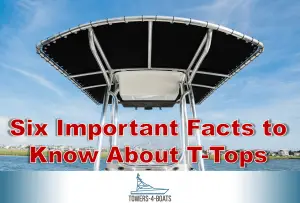The decision of twin versus single outboards is a common one. When shopping for a new boat or repowering an older hull, you might find yourself wondering about the differences between having one large outboard versus two smaller ones.
Here’s a look at some of the differences between single and twin outboard boats, as well as some of the advantages and disadvantages of having two motors. Are two outboards better than one? The short answer is that it depends.
Not all boats can be set up to take twin outboards. Catamarans nearly always require twins, but smaller bay boats almost always are set up for a single. Without custom work to the transom, two outboards just won’t fit. The most common boats that might need to pick between one or two outboard motors are offshore deep vee-shaped fishing boats, usually in the mid-twenty foot range.
Read my article on picking the best small outboard engine.
Reasons to Consider a Twin Outboard Setup
There are really only two reasons that people choose to rig two engines instead of one. Some huge boats may require more horsepower than one engine alone can make. There are some very high-powered outboard motors on the market now, with most of the top manufacturers making V-8 models that are well above 300 horsepower. But there are also a lot of big and heavy boat hulls in the world, and for a 30-plus foot offshore center console, two engines might not even be enough. Some of these boats are putting five or six outboards on the back.
The other reason you might want to consider multiple outboards is for reliability. If you take your boat offshore or operate in remote areas, having two engines means that you have a backup system. You have a backup alternator to make power, and while you might be slower, you have some maneuverability to get home if one engine dies.
Beyond having redundancy, twin outboard boats offer a few other advantages. A twin-engine boat has the upper hand when maneuvering in tight marinas. The skipper can use differential thrust to turn the boat tightly, usually within its length. The newest fly-by-wire motors and steering systems are computerized, allowing for amazingly easy docking with simple joystick control. You move the joystick in the direction you need the boat to go, and the computer system independently moves each motor and applies forward or reverse power to achieve the desired result. For big boats docking in tight marinas, nothing could be more welcome.
Beyond docking in tight spaces and having redundancy, driving a twin boat isn’t that much different from operating a boat with a single outboard. The helm will control both motors together for turning and maneuvering. Most modern systems synchronize the trim and power settings together so that the skipper only needs to change one control at a time.
Article: What is the Best Outboard Motor for Saltwater
Disadvantages to Two Outboard Motors
Of course, it’s not all good news. Buying two outboards for your boat means, well, buying two outboards for your boat. Outboards are some of the most expensive durable goods you’ll find. They are priced high at the outset because the manufacturers know that you won’t be buying another one for a very long time.
The cost of purchasing two engines is rarely less than the cost of buying one big engine. In other words, bigger engines are more expensive than smaller ones, but they are seldom twice the price. From the start of your project, buying two motors is going to cost more.
There are other costs to consider, as well. Rigging two outboards is about twice as much work as rigging two. It will require twice the amount of labor, and it will require twice as many parts. It will require two sets of controls, two sets of gauges, two steering linkages, and two fuel lines and filters. It would not be unreasonable to expect the rigging costs of twin outboards to be double or more that of a single outboard installation.
When comparing boats that are rigged with the same amount of horsepower, like one 300-horsepower motor instead of twin 150s, the math does not work out in the twin owner’s favor. Twin motors will create more drag, so for the same amount of horsepower and the same boat weight, the top-end speed and hole shot will be better for single-engine boats.
Most 300 horsepower engines are V-6 models, whereas the 150s are inline four cylinders. The weight of two outboards is double, whereas a larger V-6 is going to make most of its power for very little additional weight over one I-4. Having less weight on the transom will mean that the boat will perform and balance better. It might also be an essential consideration if you are repowering an older boat that came with two-stroke engines. Two-stroke motors were much lighter than modern four-strokes, so weight is a significant factor when repowering.
If you are making your choice based on fuel consumption, then a larger, single outboard motor will win, hands down. Two engines will always burn more fuel that one engine to produce the same amount of horsepower.
Is It Really Safer to Have Two Engines?
The number one argument for having two motors is that you have a backup if one fails. But what are the chances that one will fail? The truth is, today’s outboards are more reliable than ever before. Gone are the days of fickle maintenance hogs that flood easily and suffer from clogged carbs. Today’s EFI (electronically fuel injected) outboards are just as reliable as our cars have become. There aren’t too many that have problems.
With that in mind, it’s also worth thinking about this. If you have two outboards on your boat, you are twice as likely to have a problem with one of them. To begin with, the odds of having a problem are very low. But if you have two of them on board, then your chances double. This line of thinking is well known to professional aircraft pilots. When learning to fly multiengine airplanes, many believe that they are safe from having an engine failure. What they learn in training, however, is that they are now exactly twice as likely to suffer an engine failure.
The most common problems that affect outboard motors today are fuel related. Water contamination or low-quality ethanol fuels are common culprits. But unless your boat has two completely independent fuel systems with two separate tanks, any fuel issue is likely to affect both of your engines at the same time. And even if you do have two tanks, it’s possible that the problem would affect them both. Whether you have one outboard or two, keeping your fuel tanks clean and using high-quality fuel-water separators are vital to engine reliability.
Discuss Your Project with a Professional Repower Center
If you’re looking to repower your boat, understand that many factors go into the decision. The engine manufacturers provide a lot of information on their websites. For example, on the Yamaha website you can browse performance reports for many different hull and engine combinations. It’s relatively easy to find a boat like yours and gauge the difference that possible engine size and configurations could make.
While looking at information online can lead to some valuable insight, there are just too many variables at play when repowering a boat. A professional mechanic who repowers boats like yours can give you an honest assessment of the pros and cons of using one engine or using two.
The setup and rigging of an outboard engine are relatively straight-forward and uncomplicated, but the thought and planning that goes into a proper repower job are pretty incredible. Every hull design is slightly different, and it might not be as easy as it appears to go from one engine to two or vise versa. Before you dive into any big project on your boat, you need to run through the hows and whys to ensure there will be no costly surprises.
Beyond just the choice of engines and their arrangement, selecting the correct prop size and pitch is critical to getting the best performance out of your boat. Propping the boat is part of the repowering project, and working with an experienced shop to make it happen right is imperative. With repowers, prop sizing might be a bit of trial and error, and you want to make sure you can send the errors back and get a full refund. Working with a shop makes the process as pain-free as possible.
Conclusion
Boat projects have a way of snowballing, and repowers are no exception. With the high cost and installation requirements of outboard motors, it pays to seek professional advice related to your exact make and model of boat.
If you’re shopping for a new boat, the dealer and the factory are likely great sources of information. New boats are rigged a specific way for specific reasons, and chances are you can find out what those reasons are. Call around and investigate.
There’s no right or wrong answer to picking between a single or twin outboard setup. It comes down far more to your personal preference and your style of boating.

![You are currently viewing Twin Outboards on Small Boat [Key Facts]](https://towers4boats.com/wp-content/uploads/2020/10/Twin-Outboards-on-Small-Boat.jpg)


